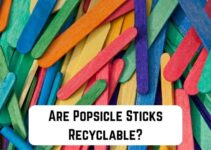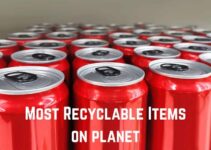We’ve all had friends over for dinner and had a lot of leftovers, so much so that it‘ll be simply ridiculous and wasteful to throw them out. So, we reach for the nearest storage container to put the leftovers in. And because they are so common, these storage containers are probably made of plastic.
Plastic containers are a popular choice because they are versatile, highly durable, cost-effective, and offer greater flexibility than any other storage material. We can also use them to store and organize several items and materials, including computer parts such as cables, stationery, medicine, or archiving files.
But despite these very intriguing benefits of plastic food containers, as consumers that are becoming very eco-conscious, we must take a step back to evaluate the safety of these packaging materials to us and the environment. This means assessing whether or not you can recycle them and get vital information on the intricacies of the recycling process.
So, in this blog post, we’ll determine if we can recycle plastic food containers and the other suitable ways to dispose of them. Let’s get started!
Can Plastic Food Containers be recycled?
Most homes, restaurants, and commercial kitchens switch to plastic food containers as they are safe for storing food at room temperature in a refrigerator.
They don’t react with ingredients in the food, thereby preserving the hygiene of the food and extending the freshness of the food, minimizing the growth of mold, and preventing bacterial growth.
However, you eventually need to dispose of damaged and broken plastic containers. Even if they aren’t damaged or broken, you can’t use the old ones forever. Old plastics can be potentially harmful because they can release chemicals into your food over time.
Whether you want to get rid of your plastics because they are too old or because you want to live a plastic-free eco-friendly life, throwing your unused or worn-out plastic containers in the trash might not necessarily be the most environmentally friendly method for disposing of them.
It instead contributes to environmental pollution as plastics take a very long time for them to biodegrade and when it finally biodegrades, it releases chemicals that can harm the environment.
However, when the time comes for your old plastic to retire, even after reusing it countless times, a viable option instead of just tossing it into the trash is recycling.
So, can you recycle plastic food containers? Yes, you can. Again, it’s best to check the bottom of the container for specific numbers or recycling symbols. They determine whether or not the plastic container is recyclable and where you can recycle it.
Plastics are recycled by first sorting by polymer type, then shredding, washing, melting, pelletizing, and then finally made into a new product. It’s a two-step process; the first is sorting and is mainly done automatically with a manual sorting system to ensure they aren’t contaminated.
Once they’re sorted and cleaned, the plastics will be shredded into flakes or melted to form pellets which will be molded into new products. You can also send the plastics back to the company where you bought them so they can recycle them.
There’s a wide range of products made from recycled plastic containers. Some include carrier bags and garbage bags, underground drainage systems for homes, and other infrastructures.
Other products include flower pots, watering cans or seed trays, guttering and window profiles used in construction, reusable pallets and crates, wheel bins and food caddies, composters and wormeries, drink bottles and food trays, or even polyester fabric for clothing.
Can You Recycle Plastic with Food in It?
Recycling plastics might seem like a breeze: as easy as tossing it into a recycling bin. But the process isn’t as straightforward as it appears.
When recycling plastic containers, you must ensure that they are free of food residues on or in them. Therefore, it’s essential to rinse out plastics to simplify recycling. It’ll also help prevent odor from recycling containers. A quick rinse, in this case, will suffice.
Plastics set for recycling must be of decent quality. Plastics contaminated with food waste can lead to the disposal of those plastics, which can cause damage to the environment because plastics take a long time to biodegrade.
So, you must wash your plastics set for recycling first before sending them out, as any contamination can ultimately affect the quality of recycled plastic produced at the end.
It’s best to separate plastic containers from other garbage. You can even have a separate bin or bags for plastic containers.
You also have to deal with the lids on the plastics as they are sometimes not made of the same type of plastics; and are therefore recycled separately. Some recycling facilities accept only the container, so it’ll do you a lot of help to ask the recycling center to avoid being turned away.
What Plastic Types are Recyclable and Which Ones are Not Recyclable?
Plastics are as versatile as they are recyclable. Recycling your plastics reduces its impact on the environment. However, not all plastics were created equal.
While buying plastic containers, you must have seen certain numbers from 1 through 7 on the bottom or side of the container. They can be easy to miss, but these numbers are significant as they are the plastic IDs.
These numbers are known as “Resin Identification Code” or “recycling number” and assist consumers who want to sort and recycle different types of plastic containers.
The Resin Identification Code helps to recycle plants and collectors, and consumers to determine what items will be accepted and how they’ll be processed.
Plastics with number 1 are “polyethylene terephthalate,” popularly known as PET or PETE plastics, and are the most frequently recycled ones.
Plastics with number 2 are high-density polyethylene, or HDPE, stronger than PET plastics.
Plastic 3 is Polyvinyl Chloride (PVC).
Plastic 4 is LDPE or Low-Density Polyethylene.
Plastic 5 is Polypropylene or PP and has a high melting point.
Plastic 6 is Polystyrene, PS, and is an incredibly versatile plastic.
Finally, plastic 7 has no name for its category and is more of a miscellaneous category because it is made from multiple plastic types that recycling facilities cannot easily recycle.
Plastics numbered 1, 2, 4, and recyclers can recycle 5 at most recycling centers. These are the plastics commonly used to make our food containers. Plastic 1 is the easiest to recycle and is suitable for storing food for a long time.
However, you should avoid using plastics labeled 3, 6, and 7 for food. They usually are not easily recycled and are often thrown directly into the trash-even though that is also not advised.
Plastic 2 is very strong and straightforward to recycle. While Plastic labeled 4 is considered the least toxic than other plastics and relatively the safest to use, they are often more reusable than recyclable.
So, you’ll have to check with your local recycling center to confirm if they accept LDPE plastic items for recycling. Plastic 5 is strong and light, very flexible, and can easily be recycled at local recycling centers.
Plastic 3 contains chemicals, including lead and phthalates. Plastic 6 can leach styrene, a known neurotoxin, and other harmful health effects.
Plastic 7 are often Polycarbonates (PC), which contain BPA, Bisphenol A, an industrial chemical used to make plastics since the 1960s. BPA contained in PC has been linked to numerous health problems.
Can You Donate Plastic Food Containers?
If you’re the type that loves to cook, you probably have a lot of plastic food containers in your home and might not be particularly psyched to recycle them just yet. So, what other option is there to reuse your containers? Well, you can donate it.
There are lots of local charities, child care centers, schools, and senior homes that will be able to make good use of your plastic containers. You can check the places you’re familiar with or go online to check for areas that do material exchanges.
If you’re looking to make some extra cash, you can donate your plastics to food banks. But ensure you check out the necessary conditions guiding the plastic donations before going ahead with it.
Should You Throw Away Old Tupperware Containers?
The great thing about old Tupperware is that they are pretty easy to reuse. So when you have a lot of old Tupperware at home, rather than just tossing them into the garbage bin, let your imagination run wild and get creative.
The possibilities for reusing them are limitless. However, here are a few ideas on how they can be reused or repurposed.
1. Packaging Food
Your smaller plastic containers, such as peanut jars, can be used to package overnight food dressings or used to create overnight dessert staples.
2. Garden Use
You can use large plastic yogurt tubs to construct self-watering planters. The rationale is that there’d be a water reservoir underneath for water, which plants can absorb as needed. You can even make them more appealing by painting or drawing up designs on them.
Small containers can be used as cool-looking vertical gardens. You can use them to grow seedlings or plant cuttings.
You can even use old Tupperware as a birdbath by hanging one plastic bowl from a string and securing it on a branch. You can even fill it with bird feed and attract little feathery friends into your garden.
3. First Aid Kit
Tupperware can be repurposed as a first aid kit. It’s far cheaper than buying multiple first aid kits, and what more? You get to customize your kit and fill it with your personal needs. It’ll fit in your car or your office.
If you have a pet, you can make a scoop from one of your old containers for your pet’s food or fertilizer if you have a garden. Likewise, you can recreate handy plastic containers to create a futuristic plastic-inspired chandelier.
Large plastic containers, especially those with lids, can be repurposed to store scraps of food for composting or for creating a worm bin.
4. Storage
They can also be used when doing bulk shopping to hold things you intend to get a lot of. You can turn your small plastic tins into cool-looking DIY gift or storage boxes.
Tupperware that is in terrible condition can still find uses around the house. Rather than throwing them out, you can use them to hold garden and garage tools and pesticides. You can use them to store your gear for your pets or even muddy shoes.
They can be kept at the back of your car to hold sandy or wet clothes when you leave the beach or the poolside or to keep wet umbrellas when you get in from the rain.
Conclusion
Typically, we can find many plastic food containers in the home because they’re famous for packaging food when you order in. Thankfully, there are many things you can do with old Tupperware. So instead of throwing them out when they’re old and worn out, you can give a few of our ideas a try.






